Abstract
Little is known about the cellular physiology of Escherichia coli at high cell densities (e.g., greater than 50 g [dry cell weight] per liter), particularly in relation to the cellular response to different growth conditions. E. coli W3100 cultures were grown under identical physical and nutritional conditions, by using a computer-controlled fermentation system which maintains the glucose concentration at 0.5 g/liter, to high cell densities at pH values of 6.0, 6.5, 7.0, and 7.5. The data suggest a relationship between the pH of the environment and the amount of acetate excreted by the organism during growth. At pH values of 6.0 and 6.5, the acetate reached a concentration of 6 g/liter, whereas at pH 7.5, the acetate reached a concentration of 12 g/liter. Furthermore, at pH values of 6.0 to 7.0, the E. coli culture undergoes a dramatic metabolic switch in which oxygen and glucose consumption and CO2 evolution all temporarily decreased by 50 to 80%, with a concomitant initiation of acetate utilization. After a 30-min pause in which approximately 50% of the available acetate is consumed, the culture recovers and resumes consuming glucose and oxygen and producing acetate and CO2 at preswitch levels. During the switch period, the specific activity of isocitrate lyase typically increases approximately fourfold.
Full text
PDF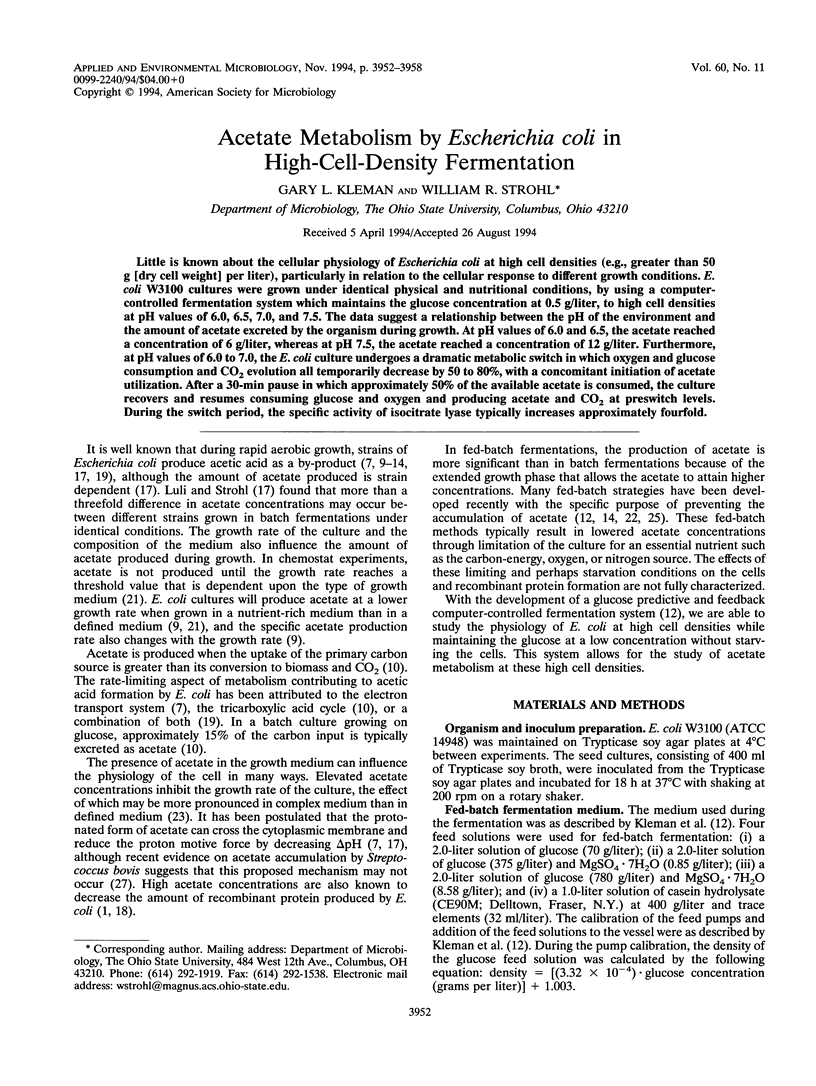
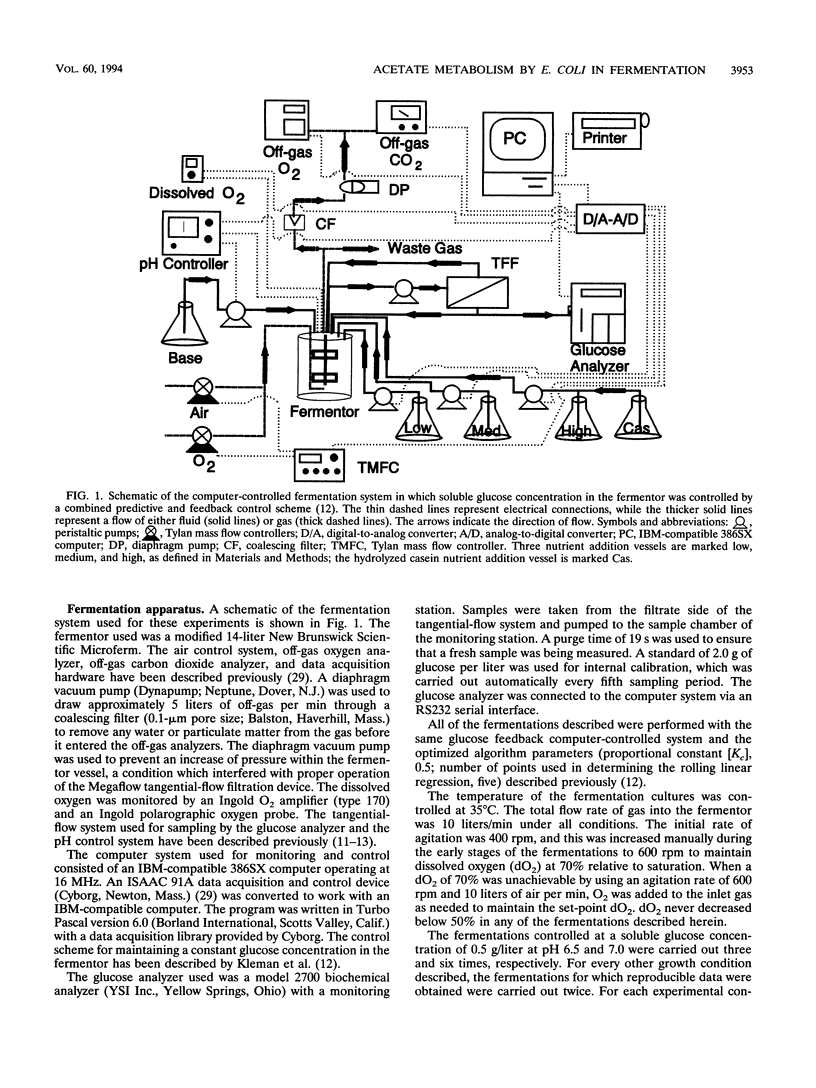
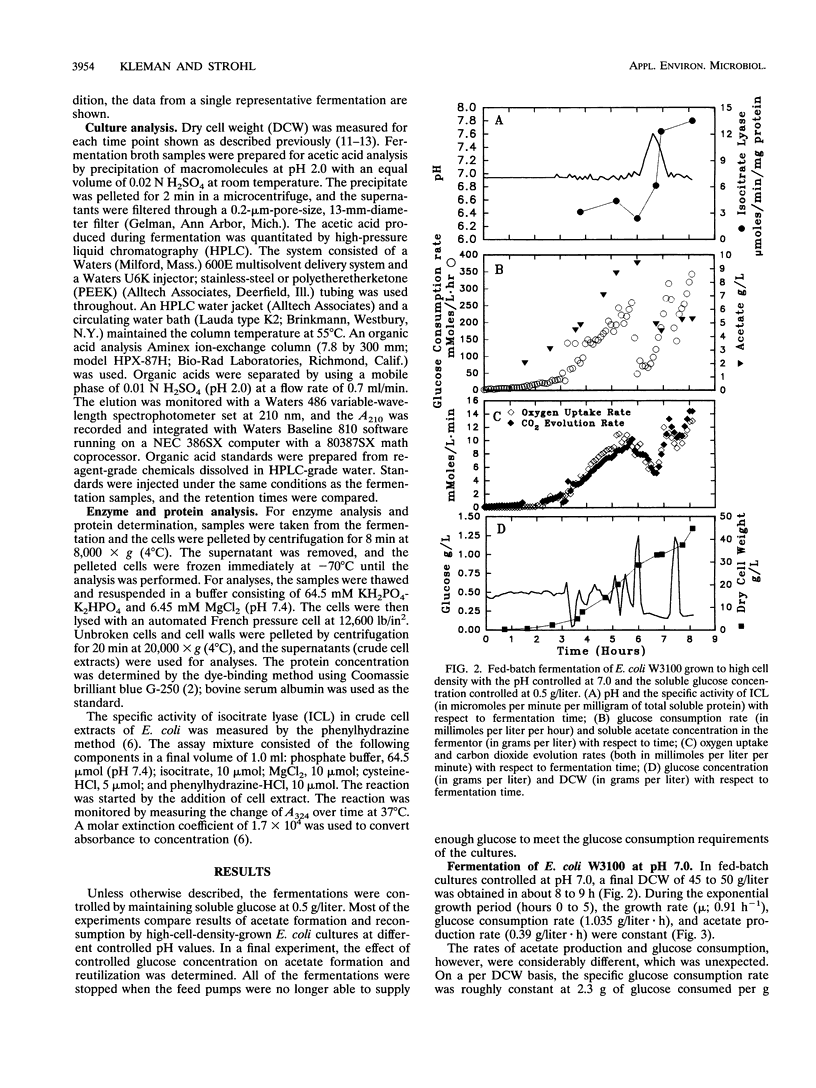


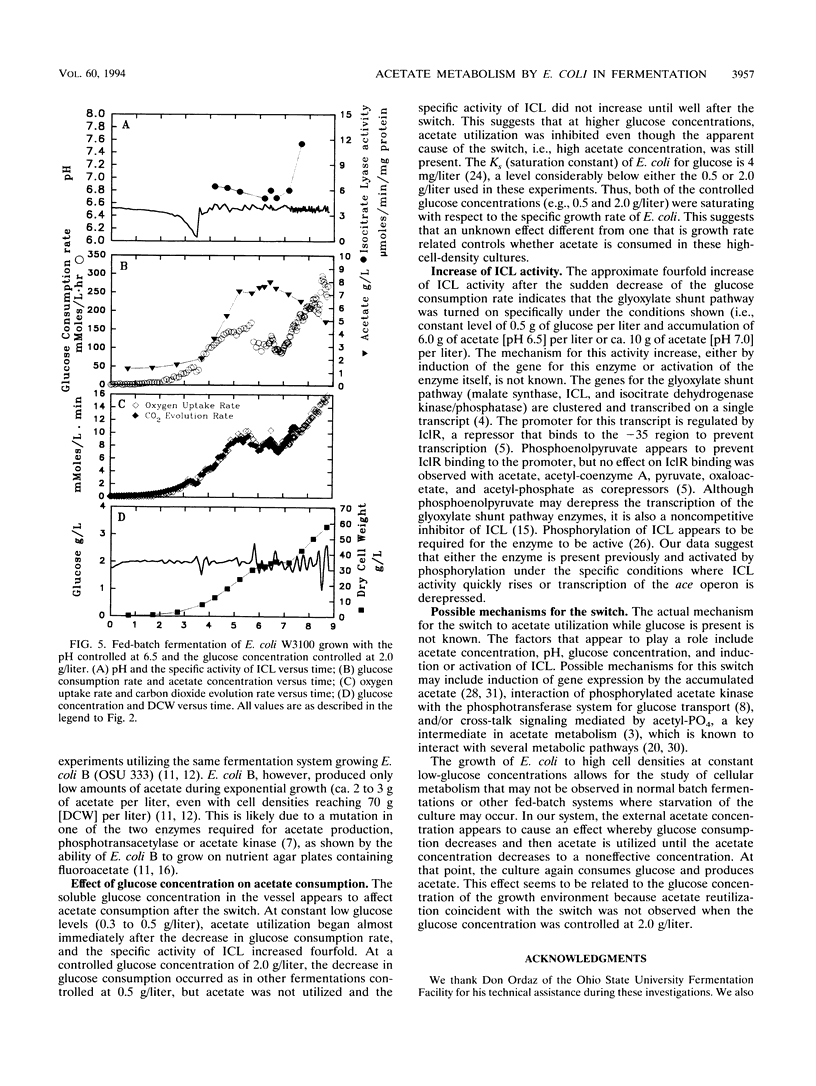
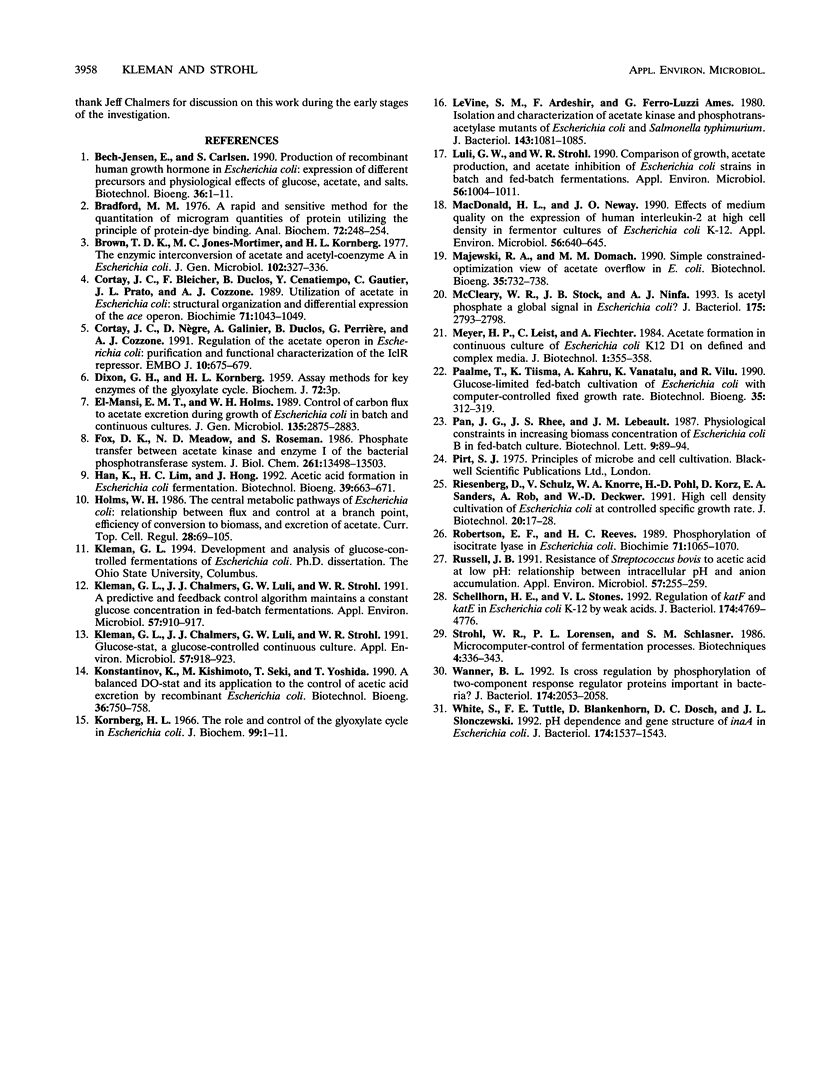
Selected References
These references are in PubMed. This may not be the complete list of references from this article.
- Bradford M. M. A rapid and sensitive method for the quantitation of microgram quantities of protein utilizing the principle of protein-dye binding. Anal Biochem. 1976 May 7;72:248–254. doi: 10.1016/0003-2697(76)90527-3. [DOI] [PubMed] [Google Scholar]
- Brown T. D., Jones-Mortimer M. C., Kornberg H. L. The enzymic interconversion of acetate and acetyl-coenzyme A in Escherichia coli. J Gen Microbiol. 1977 Oct;102(2):327–336. doi: 10.1099/00221287-102-2-327. [DOI] [PubMed] [Google Scholar]
- Cortay J. C., Bleicher F., Duclos B., Cenatiempo Y., Gautier C., Prato J. L., Cozzone A. J. Utilization of acetate in Escherichia coli: structural organization and differential expression of the ace operon. Biochimie. 1989 Sep-Oct;71(9-10):1043–1049. doi: 10.1016/0300-9084(89)90109-0. [DOI] [PubMed] [Google Scholar]
- Cortay J. C., Nègre D., Galinier A., Duclos B., Perrière G., Cozzone A. J. Regulation of the acetate operon in Escherichia coli: purification and functional characterization of the IclR repressor. EMBO J. 1991 Mar;10(3):675–679. doi: 10.1002/j.1460-2075.1991.tb07996.x. [DOI] [PMC free article] [PubMed] [Google Scholar]
- Fox D. K., Meadow N. D., Roseman S. Phosphate transfer between acetate kinase and enzyme I of the bacterial phosphotransferase system. J Biol Chem. 1986 Oct 15;261(29):13498–13503. [PubMed] [Google Scholar]
- Holms W. H. The central metabolic pathways of Escherichia coli: relationship between flux and control at a branch point, efficiency of conversion to biomass, and excretion of acetate. Curr Top Cell Regul. 1986;28:69–105. doi: 10.1016/b978-0-12-152828-7.50004-4. [DOI] [PubMed] [Google Scholar]
- Kleman G. L., Chalmers J. J., Luli G. W., Strohl W. R. A predictive and feedback control algorithm maintains a constant glucose concentration in fed-batch fermentations. Appl Environ Microbiol. 1991 Apr;57(4):910–917. doi: 10.1128/aem.57.4.910-917.1991. [DOI] [PMC free article] [PubMed] [Google Scholar]
- Kleman G. L., Chalmers J. J., Luli G. W., Strohl W. R. Glucose-stat, a glucose-controlled continuous culture. Appl Environ Microbiol. 1991 Apr;57(4):918–923. doi: 10.1128/aem.57.4.918-923.1991. [DOI] [PMC free article] [PubMed] [Google Scholar]
- Kornberg H. L. The role and control of the glyoxylate cycle in Escherichia coli. Biochem J. 1966 Apr;99(1):1–11. doi: 10.1042/bj0990001. [DOI] [PMC free article] [PubMed] [Google Scholar]
- LeVine S. M., Ardeshir F., Ames G. F. Isolation and Characterization of acetate kinase and phosphotransacetylase mutants of Escherichia coli and Salmonella typhimurium. J Bacteriol. 1980 Aug;143(2):1081–1085. doi: 10.1128/jb.143.2.1081-1085.1980. [DOI] [PMC free article] [PubMed] [Google Scholar]
- Luli G. W., Strohl W. R. Comparison of growth, acetate production, and acetate inhibition of Escherichia coli strains in batch and fed-batch fermentations. Appl Environ Microbiol. 1990 Apr;56(4):1004–1011. doi: 10.1128/aem.56.4.1004-1011.1990. [DOI] [PMC free article] [PubMed] [Google Scholar]
- MacDonald H. L., Neway J. O. Effects of medium quality on the expression of human interleukin-2 at high cell density in fermentor cultures of Escherichia coli K-12. Appl Environ Microbiol. 1990 Mar;56(3):640–645. doi: 10.1128/aem.56.3.640-645.1990. [DOI] [PMC free article] [PubMed] [Google Scholar]
- McCleary W. R., Stock J. B., Ninfa A. J. Is acetyl phosphate a global signal in Escherichia coli? J Bacteriol. 1993 May;175(10):2793–2798. doi: 10.1128/jb.175.10.2793-2798.1993. [DOI] [PMC free article] [PubMed] [Google Scholar]
- Riesenberg D., Schulz V., Knorre W. A., Pohl H. D., Korz D., Sanders E. A., Ross A., Deckwer W. D. High cell density cultivation of Escherichia coli at controlled specific growth rate. J Biotechnol. 1991 Aug;20(1):17–27. doi: 10.1016/0168-1656(91)90032-q. [DOI] [PubMed] [Google Scholar]
- Robertson E. F., Reeves H. C. Phosphorylation of isocitrate lyase in Escherichia coli. Biochimie. 1989 Sep-Oct;71(9-10):1065–1070. doi: 10.1016/0300-9084(89)90112-0. [DOI] [PubMed] [Google Scholar]
- Russell J. B. Resistance of Streptococcus bovis to acetic acid at low pH: relationship between intracellular pH and anion accumulation. Appl Environ Microbiol. 1991 Jan;57(1):255–259. doi: 10.1128/aem.57.1.255-259.1991. [DOI] [PMC free article] [PubMed] [Google Scholar]
- Schellhorn H. E., Stones V. L. Regulation of katF and katE in Escherichia coli K-12 by weak acids. J Bacteriol. 1992 Jul;174(14):4769–4776. doi: 10.1128/jb.174.14.4769-4776.1992. [DOI] [PMC free article] [PubMed] [Google Scholar]
- Wanner B. L. Is cross regulation by phosphorylation of two-component response regulator proteins important in bacteria? J Bacteriol. 1992 Apr;174(7):2053–2058. doi: 10.1128/jb.174.7.2053-2058.1992. [DOI] [PMC free article] [PubMed] [Google Scholar]
- White S., Tuttle F. E., Blankenhorn D., Dosch D. C., Slonczewski J. L. pH dependence and gene structure of inaA in Escherichia coli. J Bacteriol. 1992 Mar;174(5):1537–1543. doi: 10.1128/jb.174.5.1537-1543.1992. [DOI] [PMC free article] [PubMed] [Google Scholar]
- el-Mansi E. M., Holms W. H. Control of carbon flux to acetate excretion during growth of Escherichia coli in batch and continuous cultures. J Gen Microbiol. 1989 Nov;135(11):2875–2883. doi: 10.1099/00221287-135-11-2875. [DOI] [PubMed] [Google Scholar]


